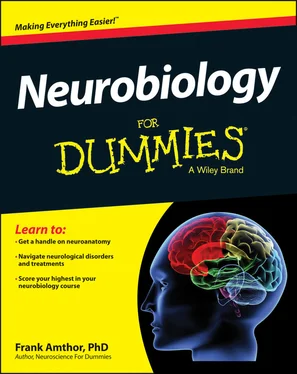 Understanding neurons as batteries
Understanding neurons as batteries
 Going with the flow through ion pumps
Going with the flow through ion pumps
 Meeting Nernst and Goldman
Meeting Nernst and Goldman
 Sending signals with electricity
Sending signals with electricity
 Exploring sodium and potassium channels
Exploring sodium and potassium channels
 Getting to know glia
Getting to know glia
If I told you that your brain is full of batteries, you’d probably wonder if I was insulting your intelligence or just plain crazy. But after you read this chapter, you’ll see that neither is the case! Your brain’s neurons are cells that specialize in rapid and precise electrical communication, integration, and processing of information. In order for neurons to perform these wonderfully complex tasks, they require a number of different cells and other components, such as membrane channels, gates, receptors, transporters, and more. In this chapter, I explore what neurons need in order to be able to detect and respond to other neurons, substances in the environment, and energy.
Looking at Membrane Channels
Neurons interact with other neurons (and the rest of the world) through membrane protein complexes (multiple proteins bound together in a structure such as a channel). (Refer to Chapter 2for more about DNA.) After the proteins are produced, they’re assembled into membrane complexes.
Talking about transporters
Cells contain ions, which are molecules that carry an electric charge. Many neurons contain transporters that have the task of pumping ions into and out of the cell.
All this transportation of ions creates a permanent imbalance between the ions inside the neuron and outside it. Different concentrations of ions exist on either side of the membrane.
You’ll get a charge out of what happens next: These ionic imbalances turn neurons into batteries, capable of producing electrical currents that flow through discrete pathways for conduction through the membrane; the biophysical term for conduction is permeability. The conduction path is made up of ion channels, which have gates that open to allow ions like sodium, potassium, or chloride to move through the membrane.
The things neurons do — such as receiving, processing, and transmitting information — all require membrane channels that form the following:
Ion-selective channels: Membrane channels typically allow only certain ions, or groups of ions, to pass through the membrane. These channels may lack gates and, therefore, run continuously, or have gates dependent on the membrane potential or neurotransmitter binding.
Secretory mechanisms: Membrane structures that use energy or concentration gradients to release substances outside the cell, such as neurotransmitters being released into the space between the pre- and postsynaptic neurons (the synaptic cleft) in a manner similar to how hormones are released into the bloodstream.
Membrane receptors: Membrane channels called ionotropic receptors can bind neurotransmitters (called ligands) that allow the flow of ions through the membrane. Some receptors, called metabotropic receptors (discussed in more detail in Chapter 4) have the reception and channel functions located in separate protein complexes in the membrane.
Ion-selective channels, as their name implies, control the movement of certain ions through plasma membranes. These channels are typically composed of four or more individual proteins (called subunits ) that combine in the membrane to form a molecular pore. Most ion channels are selective — they only allow certain ions to pass and, often, only in one direction.
Ion channels can be un-gated or gated:
Constitutively open channels: These are sometimes called leakage channels and are just like your reliable corner store because they’re always open. Their permeability (ability to pass ions) is not modulated. However, the number of these channels in the plasma membrane (and, thus, the total membrane permeability) is controlled by DNA expression. This way, total permeability may be modified.
Gated channels: These channels can be open or closed. Controlling ion movements through gated channels is fundamental to how neurons receive, process, and transfer information. Sensory receptors activate channels by receiving energy such as light or sound, or by external substances such as odors. Neurons communicate with other neurons through two types of gated channels: Ligand-gated channels are channels that are opened as a result of a molecule (typically a neurotransmitter) outside the cell binding to a complementary receptor structure inside the channel complex. (The word ligand is from a Latin word meaning “to bind.” ) In ionotropic receptors (see Chapter 4for more), the ligand binding site and gated pore are part of the same membrane protein complex. In metabotropic receptors, after binding a ligand, the receptor protein complex in the membrane activates a second messenger transmitter inside the cell whose actions may open or close other channels.Voltage-gated channels open in response to changes in membrane potential, which is the voltage difference between the inside and outside of the cell. Typically, voltage-gated channels are closed when the neuron is not excited (at the “resting potential”) and open when the cell is excited. When the neuron is excited (or stimulated), the membrane potential is depolarized (or more positive).
Neurons release neurotransmitters at their presynaptic terminals. In most neurons this happens by a process called vesicular release and works in a way that is similar to secretion. During vesicular release, calcium enters the presynaptic terminal through voltage-dependent calcium channels. ( Chapter 4discusses this process in more detail.)
Some membrane receptors act as sensors; they respond to energy or substances in the environment. To give just two examples, photoreceptors capture photons of light, and channels located in specialized hairlike structures on auditory hair cells open in response to sound waves that bend these hairlike structures.
Getting a Charge Out of Neurons
Neurons use electricity to communicate between different parts of the same neuron and between neurons. How this works is one of the most fascinating stories in all science.
The story starts with transporter pumps (refer to “Talking about transporters,”earlier in this chapter) in the membrane that create ionic imbalances between the inside and outside of the cell. Not all ions get to move through the membrane, and the ligand-gated and voltage-gated channels act as the membrane’s “bouncers,” allowing only specific ions to move through. Then, voltage-gated channels amplify the effects caused by ligand binding so that distant parts of the cell’s dendritic tree communicate these events to the cell’s soma. The cell’s soma then communicates the dendritic events to the axon terminal, which releases neurotransmitters that affect other neurons, and the symphony of brain activity plays on.
Читать дальше

 Understanding neurons as batteries
Understanding neurons as batteries










